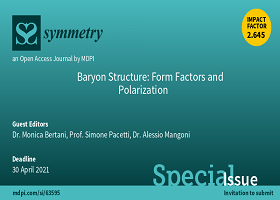Baryon Structure: Form Factors and Polarization
A special issue of Symmetry (ISSN 2073-8994). This special issue belongs to the section "Physics".
Deadline for manuscript submissions: closed (31 January 2022) | Viewed by 19854

Special Issue Editors
2. INFN Sezione di Perugia, 06100 Perugia, Italy
Interests: hadron physics; phenomenology and theory of particle physics
Special Issue Information
The study of baryons is one of the greatest challenges in particle physics. It is fundamental for a deep understanding of the dynamical mechanisms that rule quantum chromodynamics, the QCD, at energy regimes where the perturbative character of this gauge theory is still not effective because of the so-called phenomenon of color confinement. Baryons, unlike elementary particles, have an internal structure of three valence quarks surrounded by a dynamical and intensely interacting sea of virtual quark-antiquark pairs and gluons. From a theoretical point of view and in the framework of quantum field theory, the most general description of the mechanisms that underlie and hence rule baryon dynamics is grounded on the concept of form factors. They represent energy-dependent coupling constants that parametrize the baryon four-currents and encode all the information concerning their dynamics.
Form factors are complex quantities, and their complex nature manifests in the polarization of the baryons that are produced in charmonium decays and in electron-positron annihilation processes, respectively. By taking advantage of the self-analyzing weak decays of hyperons, their polarization and hence the complexity of form factors are observable, and moreover, eventual connections between the strong and the electromagnetic dynamics can be studied.
In recent years, a growing number of experiments has been providing more and more sets of data that, with high accuracy and covering all kinematic regions, are going to complete, piece by piece, the complex puzzle of baryons form factors and their polarization. The interpretation of such an impressive amount of experimental information does require a solid and well established theoretical framework.
This Special Issue has been conceived to provide an exhaustive and updated answer to such a request by collecting, organizing, and framing all the available data, both experimental and theoretical, on baryon cross-sections and polarization observables in a unique treatment.
Dr. Monica Bertani
Prof. Simone Pacetti
Dr. Alessio Mangoni
Guest Editors
Manuscript Submission Information
Manuscripts should be submitted online at www.mdpi.com by registering and logging in to this website. Once you are registered, click here to go to the submission form. Manuscripts can be submitted until the deadline. All submissions that pass pre-check are peer-reviewed. Accepted papers will be published continuously in the journal (as soon as accepted) and will be listed together on the special issue website. Research articles, review articles as well as short communications are invited. For planned papers, a title and short abstract (about 100 words) can be sent to the Editorial Office for announcement on this website.
Submitted manuscripts should not have been published previously, nor be under consideration for publication elsewhere (except conference proceedings papers). All manuscripts are thoroughly refereed through a single-blind peer-review process. A guide for authors and other relevant information for submission of manuscripts is available on the Instructions for Authors page. Symmetry is an international peer-reviewed open access monthly journal published by MDPI.
Please visit the Instructions for Authors page before submitting a manuscript. The Article Processing Charge (APC) for publication in this open access journal is 2400 CHF (Swiss Francs). Submitted papers should be well formatted and use good English. Authors may use MDPI's English editing service prior to publication or during author revisions.
Keywords
- form factors
- polarization
- entanglement
- hyperons
- quantum chromodynamics
- effective theories
- hadronic decays
- baryon–antibaryon asymmetry
- CP test
Benefits of Publishing in a Special Issue
- Ease of navigation: Grouping papers by topic helps scholars navigate broad scope journals more efficiently.
- Greater discoverability: Special Issues support the reach and impact of scientific research. Articles in Special Issues are more discoverable and cited more frequently.
- Expansion of research network: Special Issues facilitate connections among authors, fostering scientific collaborations.
- External promotion: Articles in Special Issues are often promoted through the journal's social media, increasing their visibility.
- e-Book format: Special Issues with more than 10 articles can be published as dedicated e-books, ensuring wide and rapid dissemination.
Further information on MDPI's Special Issue polices can be found here.







